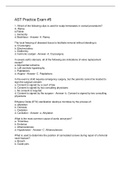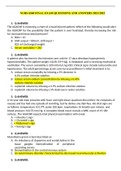In severe aorti - Study guides, Class notes & Summaries
Looking for the best study guides, study notes and summaries about In severe aorti? On this page you'll find 3 study documents about In severe aorti.
All 3 results
Sort by

-
AST Practice Exam #5
- Exam (elaborations) • 16 pages • 2023
-
- $12.49
- + learn more
1. Which of the following clips is used for scalp hemostasis in cranial procedures? A. Raney b.Filshie c. Hemoclip d. Backhaus - Answer- A. Raney The local freezing of diseased tissue to facilitate removal without bleeding is: a. Cryosurgery b. Electrocautery c. Diathermy d. harmonic scalpel - Answer- A. Cryosurgery In severe aortic stenosis, all of the following are indications of valve replacement except? a. Myocardial ischemia b. Left ventricle hypertrophy c. Palpitations d...

-
NBME 26 Questions Answered 100% correct 2023
- Exam (elaborations) • 9 pages • 2023
-
Available in package deal
-
- $19.49
- + learn more
NBME 26 Questions Answered 100% correct 2023 Absence of the gamma region on SPEP indicates immunodeficiency with hypogammaglobulinemia or agammaglobulienmia increased left atrial pressure during ventricular systole on the pressure-time graph indicates mitral regurgitation, likely from rupture of the chordae tendinae Mannitol's effect on serum osmolality increases serum osmolality (and in turn, triggers production of ADH) hypoventilation is characterized by increased Pa...

-
NURS 6560 FINAL EXAM QUESTIONS AND ANSWERS 2021/2022 - WALDEN UNIVERSITY
- Exam (elaborations) • 28 pages • 2022
-
- $16.99
- + learn more
1. Q ANSWER: The AGACNP is reviewing a chart of a head-injured patient. Which of the following would alert the AGACNP for the possibility that the patient is over hydrated, thereby increasing the risk for increased intracranial pressure? A. BUN = 10 B. Shift output = 800 ml, shift input = 825 ml Unchanged weight C. Serum osmolality = 260 2. Q ANSWER: A patient who has been in the intensive care unit for 17 days develops hyponatremic hyperosmolality. The patient weighs 132 lb (59.9 kg),...

How much did you already spend on Stuvia? Imagine there are plenty more of you out there paying for study notes, but this time YOU are the seller. Ka-ching! Discover all about earning on Stuvia


